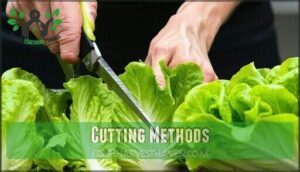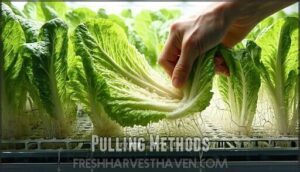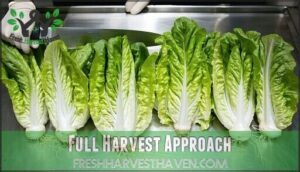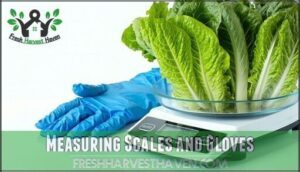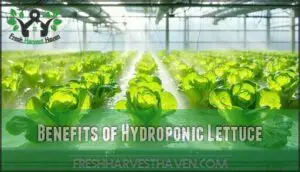This site is supported by our readers. We may earn a commission, at no cost to you, if you purchase through links.
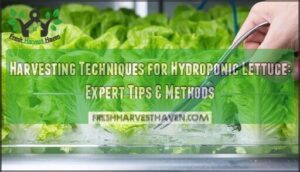
Cut outer leaves with clean scissors when they’re 4-6 inches long, leaving the center to keep growing. For head lettuce, harvest the entire plant once it feels firm and dense.
Always cut above the root system to avoid contamination. Rinse harvested leaves immediately in cool water and store them in the refrigerator at 32-36°F with high humidity.
The "cut-and-come-again" method lets you harvest multiple times from the same plant, maximizing your yield. Smart harvesting isn’t just about when to cut—it’s about preserving quality and extending shelf life through careful handling.
Table Of Contents
Key Takeaways
- Harvest lettuce leaves when they are 4-6 inches long and show vibrant color; trust your eyes and leaf firmness over the calendar.
- Use clean, sharp scissors or knives to cut outer leaves above the root system, or harvest the whole plant for head varieties.
- Rinse leaves in cold water, dry gently, and store them in breathable containers in the fridge at 32-36°F with high humidity.
- The cut-and-come-again method lets you harvest multiple times from the same plant, maximizing yield and freshness.
Harvesting Hydroponic Lettuce
You’ll know your hydroponic lettuce is ready to harvest when the leaves reach 4-6 inches in length and display vibrant, healthy colors.
The timing typically falls between 30-50 days after planting, though this varies by variety and growing conditions, and the leaves are key indicators of readiness.
Choosing Right Harvest Time
Timing your hydroponic lettuce harvest correctly separates amateur growers from seasoned pros.
Visual cues tell the whole story—watch for vibrant green leaves and firm texture that signals peak leaf readiness.
**Trust your eyes over the calendar—mature leaves show perfect harvest timing.
Your ideal window typically opens between 30-50 days after planting, depending on variety.
Growth stage matters more than calendar dates.
Test readiness with gentle tugs; mature leaves resist slightly before releasing.
Trust these indicators of readiness over guesswork, and consider the growth stage.
Leaf Size and Color
When judging hydroponic lettuce harvest readiness, you’ll want to look for ideal size leaves measuring 4-6 inches in length.
Vibrant color indicates healthy nutrient impact and proper maturity stages, with different lettuce varieties showing unique color indicators – butterhead displays rich green hues while romaine develops deeper coloration.
Dull or yellowing leaves signal overmaturity, affecting firmness and flavor quality in your hydroponic lettuce harvest, which is why monitoring for these signs is crucial to determine the proper maturity stages.
Firmness and Maturity
Three key indicators reveal when your hydroponic lettuce reaches peak maturity.
First, test leaf firmness by gently pressing leaves—they should feel crisp and substantial, not limp or overly tender.
Second, examine head density for varieties like romaine; properly mature heads feel compact when squeezed.
Finally, conduct a taste test during your harvest window to guarantee the best flavor development before the growth stage advances too far.
Proper soil preparation, as well, impacts crop maturity, is crucial for a successful harvest.
Harvesting Techniques
Once you know when to harvest your hydroponic lettuce, choosing the right technique becomes essential for getting the best yield and quality.
You’ll need to pick between cutting methods, pulling techniques, or full harvest approaches depending on your lettuce variety and growing goals.
Cutting Methods
When cutting hydroponic lettuce, sharp tools make all the difference.
Use clean scissors or a sharp knife to slice stems at a 45-degree angle, about 1-2 inches above the base.
This stem angle promotes faster regrowth speed while minimizing leaf damage.
Tool sharpness prevents bruising and guarantees clean cuts.
Proper harvest height maintains the plant’s core for continuous production in your hydroponic system.
Proper growth requires maintaining a pH between 5.5–6.8.
Pulling Methods
For hydroponic lettuce, the pulling method offers distinct advantages over cutting techniques.
You’ll grasp the plant at its base and gently lift it from the growing medium, keeping roots largely intact.
This approach prevents root damage while minimizing soil contamination risks.
The pulling method excels in nutrient absorption preservation and reduces plant exhaustion compared to repeated cutting.
Method comparison shows pulling works best for whole-head harvesting.
Hydroponic systems allow for precise nutrient control.
Full Harvest Approach
When your lettuce reaches plant maturity, the full harvest approach means complete removal of the entire plant, including its root system.
This harvesting hydroponics method is perfect for commercial packaging or single use consumption. You’ll cut the stem at the base, taking everything at once.
Unlike selective harvesting techniques, this lettuce harvesting method gives you the whole plant but ends its growing cycle permanently.
To maximize flavor, consider the morning harvesting benefits.
Post Harvest Care
Once you’ve harvested your hydroponic lettuce, proper post-harvest care becomes essential for maintaining freshness and extending shelf life.
You’ll need to handle your crisp greens with care to preserve their quality and nutritional value for days to come.
Rinsing and Drying
Once you’ve harvested your fresh hydroponic lettuce, it’s time to clean it properly.
Water Temperature matters—use cold water to maintain crispness.
Here’s your step-by-step approach:
- Rinse leaves gently under cold water to remove any debris
- Pat dry with paper towel or clean cloth to prevent wilting
- Use gentle motions for Preventing Bruising during handling
- Remove excess moisture completely before Storage Preparation
- Check leaves for damage that could affect Shelf Life
These Drying Methods guarantee your lettuce stays fresh longer.
Storage and Handling
Once you’ve properly cleaned your hydroponic lettuce, smart storage becomes the key to preserving its freshness. Store your leaves in breathable containers with paper towels to absorb excess moisture.
Proper packaging methods and ethylene sensitivity awareness will maximize shelf life while maintaining ideal temperature control. To maintain ideal conditions, consider using perforated bags usage for airflow.
| Storage Factor | Best Practice | Impact on Freshness |
|---|---|---|
| Container Type | Breathable plastic bags or clamshells | Prevents moisture buildup |
| Moisture Control | Damp paper towel placement | Maintains crispness without decay |
| Packaging Material | Food-grade, aerated containers | Extends shelf life 2-6 days |
| Ethylene Exposure | Keep away from apples/bananas | Prevents premature spoilage |
| Handling Method | Gentle transfer, minimal processing | Reduces bruising and damage |
Your hydroponic lettuce needs room to breathe. Cramming leaves into tight spaces creates bruising that shortens storage life. Think of proper postharvest care like giving your greens a comfortable hotel room rather than cramped quarters, ensuring gentle handling and minimal processing to reduce damage and promote a longer shelf life with ideal temperature control.
Give your hydroponic lettuce the VIP treatment it deserves—proper spacing prevents bruising and extends freshness.
Refrigeration and Humidity
Once you’ve properly cleaned and dried your lettuce, maintaining ideal temperature becomes your next priority.
Store your harvest in the refrigerator between 32°F and 36°F to preserve freshness. Control humidity around 95% using damp paper towels in your packaging methods.
This cool environment prevents wilting and extends storage duration up to seven days, keeping your crisp greens ready for any meal.
Tools and Equipment
Having the right tools makes harvesting your hydroponic lettuce quick and efficient. You’ll need just a few basic items to get clean cuts and handle your fresh greens properly.
Sharp Knives and Scissors
Beyond just grabbing any blade, you’ll want stainless steel or titanium-coated knives and scissors for hydroponic lettuce harvesting techniques.
These blade materials resist rust while enabling easy sanitation practices between plants.
Sharp tools deliver cutting precision that prevents leaf bruising and disease spread.
Handle ergonomics matter too—comfortable grips reduce fatigue during extended harvesting sessions.
You can find specialized hydroponic lettuce knives designed for this purpose.
Regular sharpening techniques maintain blade effectiveness, ensuring clean cuts that promote faster regrowth in your lettuce harvesting methods.
Containers and Baskets
Once you’ve mastered your sharp knife technique, you’ll need proper containers and baskets for collecting your hydroponic lettuce harvest. Material choices matter—food-grade plastic or stainless steel work best.
Size considerations depend on your garden scale, while breathability needs require ventilation holes. Consider exploring different hydroponic growing systems for efficient lettuce cultivation.
- Wide-mouth baskets with mesh bottoms for drainage
- Shallow containers preventing leaf crushing under weight
- Liner options like clean towels for delicate varieties
Container sanitation between harvests prevents contamination. Smart harvesting techniques for beginners include using multiple smaller containers rather than cramming everything into one basket.
Measuring Scales and Gloves
Accurate measurements transform your harvest from guesswork to precision.
You’ll need reliable measuring scales for tracking yields and quality gloves that protect your hands while maintaining dexterity.
These harvesting tools guarantee both hygiene standards and efficiency.
| Tool Feature | Scale Calibration | Glove Material |
|---|---|---|
| Accuracy Level | Weight Accuracy ±0.1g | Ergonomic Gloves fit |
| Hygiene Standards | Easy-clean surface | Washable materials |
| Durability | Digital precision | Tear-resistant |
| Comfort | Compact design | Compact design |
| Cost Range | $15-50 | $5-20 |
Digital scales help you monitor harvesting techniques effectiveness, while nitrile or latex gloves prevent contamination of your hydroponic lettuce during handling.
Consider using a scale for precise lettuce weighing.
Benefits of Hydroponic Lettuce
When you harvest hydroponic lettuce, you’re getting much more than just fresh greens for your salad bowl.
Hydroponic systems offer distinct advantages that make your lettuce-growing efforts more efficient, sustainable, and productive than traditional soil methods, providing a clear benefit through sustainable practices.
Water Conservation
Efficiency flows like water through every hydroponic system you’ll build.
Recirculation systems let you slash water usage by up to 90% compared to traditional farming methods. Your hydroponic lettuce harvest benefits from these sustainable practices that protect our planet’s resources.
- Recirculating water cycles nutrient solutions continuously, eliminating waste
- Smart sensors monitor water levels, preventing overuse during lettuce harvesting process
- Closed-loop systems capture and reuse every drop for efficient water use
Space Efficiency
Your hydroponic system harvest transforms tiny spaces into productive powerhouses.
Vertical systems let you stack lettuce layers, multiplying your yield without expanding your footprint.
Indoor gardens and urban farming setups maximize every square inch, with compact varieties thriving in these configurations, delivering fresh harvests from surprisingly small areas.
Smart space efficiency means more hydroponic lettuce from less room, resulting in surprisingly small areas and productive powerhouses.
Year Round Production
Yearround production means you’ll never face the disappointment of empty salad bowls when winter arrives. Hydroponic lettuce harvest continues regardless of seasons, giving you fresh greens every single day.
Here’s what makes consistent harvesting possible:
- Climate Control maintains perfect growing temperatures despite weather changes
- Lighting Systems replace sunlight during shorter winter days
- Variety Selection lets you grow different lettuce types simultaneously
- Nutrient Management keeps plants fed with precise requirements
- Consistent Yields deliver predictable harvests for meal planning
This harvesting for beginners advantage transforms your kitchen into a reliable source of hydroponic lettuce tips success. To optimize nutrient use in your system, consider crop rotation basics.
Reduced Pesticide Use
With closed systems and nutrient control at your fingertips, you’ll slash pesticide dependency by up to 90%.
Your hydroponic lettuce harvest thrives on natural defenses while pest resistance builds through organic nutrients.
These controlled environments create freshness that conventional farming can’t match. Clean harvesting techniques mean you’re getting pure, chemical-free greens straight from your system.
Faster Growth Rates
Something magical happens when you ditch dirt for hydroponic lettuce systems.
Your greens race to maturity up to 30% faster than traditional soil methods.
Nutrient-rich water solutions and environmental control create perfect growing conditions.
With proper lighting schedules and variety selection, you’ll harvest fresh lettuce in just 4-6 weeks instead of waiting months, which is a significantly faster process.
Frequently Asked Questions (FAQs)
How to store harvested hydroponic lettuce?
Once you’ve plucked those crisp green leaves from your hydroponic paradise, time’s ticking!
Rinse gently in cold water, pat dry completely, then wrap in damp paper towels.
Before refrigerating at 32-36°F for peak freshness.
What nutrients are essential for hydroponic lettuce growth?
Your hydroponic lettuce needs nitrogen for leafy growth, phosphorus for root development, potassium for disease resistance, plus calcium, magnesium, and sulfur.
Don’t forget micronutrients like iron and manganese for peak health.
How do you prevent root rot in lettuce?
Keep roots oxygenated and water moving like a gentle stream.
Change the nutrient solution often, and don’t let water get too warm.
If roots look brown or slimy, act fast—clean, trim, and refresh everything.
Can you regrow lettuce from harvested stems?
Imagine a lettuce stem left behind after harvest—don’t toss it just yet!
You can regrow new leaves by placing the stem in water.
Give it sunlight, and soon, you’ll see fresh greens sprouting again.
What causes lettuce to bolt prematurely?
Lettuce bolts early when it gets too much heat, long daylight, or stress from inconsistent watering.
Once it starts stretching tall and flowering, the leaves turn bitter.
Think of it as lettuce’s way of saying, “I’m done!”
How do different varieties affect harvest timing?
Different varieties set their own clocks—leafy types like arugula mature fast, often ready in 30 days.
Head varieties, like romaine, take longer, usually 45–60 days.
You’ll harvest sooner or later depending on your choice.
Conclusion
Like a well-tuned orchestra, mastering harvesting techniques for hydroponic lettuce keeps your greens crisp and fresh.
You’ll know when to cut, how to handle each leaf, and the best ways to store your harvest.
Don’t forget to use clean tools and quick, careful movements, these steps protect your lettuce’s quality and boost your yield.
With practice, you’ll harvest like a pro—no wilted leaves or wasted effort, and your hydroponic lettuce will always taste garden-fresh.
- https://www.aces.edu/blog/topics/crop-production/greenhouse-lettuce-production/
- https://brightlanegardens.com/edible-garden/vegetable-garden/guide-to-harvesting-lettuce/
- https://www.youtube.com/watch?v=21YI3exfi4s
- https://www.edengreen.com/blog-collection/hydroponic-butterhead-lettuce
- https://pmc.ncbi.nlm.nih.gov/articles/PMC10625363/


